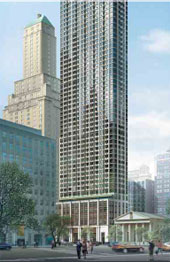 |
|||
ABO Developments |
Spring 2009 |
||
Home | Print Page |
|||
|
The New Rent Regulations The bills would return tens of thousands of units that were converted to market rate in recent years back to rent-regulated status, effectively end the practice of luxury de-control, reduce the amount a landlord can increase rent after an apartment is vacated from 20 percent to 10 percent and severely restrict an owner's ability to recoup the cost of upgrading his or her property. The timing couldn't be worse, say landlords, who are already suffering through the worst real-estate market in decades, when vacancies are rising and rents plummeting. "I think the industry is under enough pressure and stress that it doesn't need these kinds of regulations," says Gary Jacob, president of Glenwood Management, one of the largest rental owners/operators in New York City. Killing at ant with an atom bomb Landlords say the new regulations punish responsible owners for the actions of a few very opportunistic investors who rushed into the market during the recent real-estate boom. According to Ed Kalikow, principal of Kaled Property Management, "They're a response to some of the abuses that took place by speculators who assumed they could do an end run around the rent stabilization system by getting people out faster than normal. What's offensive to me as a longtime owner and operator is that we didn't participate in this practice. Instead of dealing with the people who abused the system, they're changing the system. It's a narrow-minded, simplistic approach, like killing an ant with an atom bomb." MCI cutbacks The new regulations, say industry leaders, would allow the city's housing stock to fall into disrepair. "One of the provisions that is going to severely impact owners wanting to enhance their buildings is the MCI [major capital improvements] cutbacks," says Kalikow. Under the new regulations, surcharges added to apartment rents in buildings where major improvements are made must be removed after the cost of the renovations have been recouped. Allowing landlords to permanently raise the rent on a stabilized apartment that is significantly improved according to Rent Guidelines Board standards has been one of the principal ways owners are given an incentive to maintain and upgrade their properties. "The cutbacks would act as a disincentive," says Kalikow. "As an owner, if I'm going to do a million-dollar major capital improvement to a building, I have costs that aren't necessarily reimbursable, like financing and engineering." Another section of the bill would decrease the percentage of the cost of the repairs the landlord can recover from the renovation of any single apartment. "It means," says mortgage broker David Berger, co-founder of Rosewood Realty Group, "nobody's ever going to renovate their apartments. If you can't recoup it, why bother?" Housing not getting any younger "We have an aging housing stock in New York City," says Jacob, "and it's important for owners to have incentive to reinvest money into their buildings, to make improvements. If they change the formula to make it a temporary surcharge rather than a permanent part of the rent, there's not enough of an incentive to do it. The housing stock will suffer." "These regulations," adds Berger, "will have the unintended consequences of hurting the tenants by preventing landlords from rehabilitating their buildings." The hardest hit neighborhoods would likely be those that began to emerge in the last decade, says Berger. "Upper Manhattan, Harlem, Washington Heights -- gentrification uplifted these neighborhoods and those areas will be impacted the most." The damage would extend to the larger economy, says Jacob. "Other industries are involved. All the contractors and tradespeople who make a living doing this kind of work will no longer have that work." Indeed, property owners spend about $120 million a year on major capital improvements and almost three times as much on individual apartments— almost a half a billion dollars that goes directly into the city’s economy. Ending luxury decontrol Another bill seeks to end the practice of deregulating housing units and would put formerly deregulated apartments renting for less than $5,000 a month back under stabilization. The bill is drawing objections on many grounds. While building owners sympathize with the bill’s goal of keeping working class New Yorkers from being priced out of the city, in practice, they say, it offers subsidies to people who can well afford to live without them, at the landlord’s expense. “It protects a lot of people who don’t need to be protected,” says Kalikow. “If you want me to help people, if that’s my price for doing business in New York City, I’ll do my share. But don’t make me subsidize somebody who doesn’t need to be subsidized.” Established in 1994, high-rent vacancy decontrol aimed not only to give owners inventive to maintain and improve their buildings, but also to encourage developers to build new rental units to begin to fix New York City’s seemingly never-ending housing crisis. “The whole idea was to move to a free-market system so in the long run that would create more housing,” says Jacob. The rent-regulation system as it is, adds Berger, “is flawed, but it works. And if it ain’t broke, don’t fix it.” Article featured in ABO Developments |
|||
Home | Print Page |
|||
